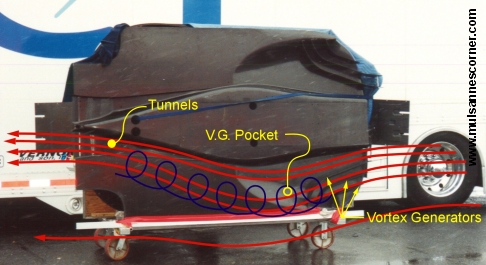Dalton, The winglets (or to use their correct name dive plates) while creating a small amount of downforce in the case of the GT40 I think are likely to have a major secondary effect. While I'm only guessing I would have thought they would improve the airflow around the front wheel area and may setup a vortex down the side of the car which would reduce air loss from underneath, down side of that theory is that the underside of the original GT40 is terrible for airflow.
JK, I think you are focusing far too much on how aeroplanes work and not how cars work, a major part of the aerodynamics of a car is the ground effect that doesn't affect a plane (Ekranoplan excepted). You dismiss ~30 years of F1 and sports car aerodynamics, why do you think F1 teams go to the expense of creating rolling road wind tunnels?
I found "Competition Car Aerodynamics - A Practical Handbook" by Simon McBeath a very good primer on the subject. You may also want to read "Race Car Aerodynamics: Designing for Speed (Technical including tuning & modifying)" by Joseph Katz
Winglets at the nose and under the diffuser plate are a very interesting option. Actually, I am thinking about this, what holds me off in the moment is simply time. I have none
Just to show, in which direction the next steps will be, a picture of the underbody of a Lola race car

I suppose, this is what you meant with reducing the air loss under the car. I'm afraid this will only work with a specifically formed underbody. But I am definitely interested go in that direction.
But I would like to dicuss about this a bit later, after we have first test results of the actual setup (ok, future setup, still not ready
Btw., my emphasis on airfoil aerodynamics was only due to the basic discussion about Bernoulli vs. Newton to describe the function of a car rear diffuser. And the ground effect is not excluded in the basic theory.
I did not read the books, you mentioned, I was reading mainly german books about that topic. So thanks for the hint, I just ordered them. I would like to collect any potentially useful bit of information

